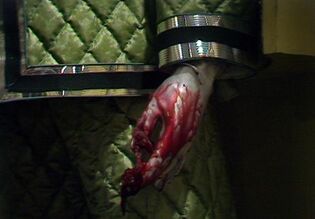Grimwade's Syndrome
- You may be looking for the audio story Robophobia.
Grimwade's Syndrome, frequently called robophobia, was a psychological condition among humans who had frequent contact with androids and robots, commonly attributed to the androids moving like humans, but without any of the characteristic and subtle movements associated with humans.
In the mind of the afflicted, they appeared to be "surrounded by walking, talking dead men." According to the Fourth Doctor, it caused "identity crisis, paranoia, sometimes even personality disintegration".
During a sandminer expedition commanded by Kiy Uvanov, one of the crew, Zilda's brother, suffered from robophobia and ran outside the mine, where he died. His father had it "hushed up" out of fear that his son would be thought a coward.
On Storm Mine 4, the undercover agent Poul found blood on the hands of a broken Voc sandminer robot, leading to a bout of robophobic mania. Leela was unable to convince him to come out of hiding. (TV: The Robots of Death)
Grant Markham suffered from robophobia, which he initially attributed to hearing Agoran stories. (PROSE: Time of Your Life) However, this was later identified as the trauma of Grant's repressed memory of his mother being killed by a Cyberman (PROSE: Killing Ground).
Farel suffered from Grimwade's after hearing his wife die in a sandstorm while surronded by Vocs. (AUDIO: Robophobia)
Behind the scenes
The name "Grimwade's Syndrome" was an in-joke reference to production assistant Peter Grimwade (later to become a director and writer on the series), who had bemoaned the fact that the stories on which he was assigned to work almost always involved robots. This was ad-libbed by Tom Baker during recording from the originally scripted "Gimwol's Syndrome". However, the description of robophobia given by the Doctor in fact coincides with a real-life phenomenon called the Uncanny Valley.

